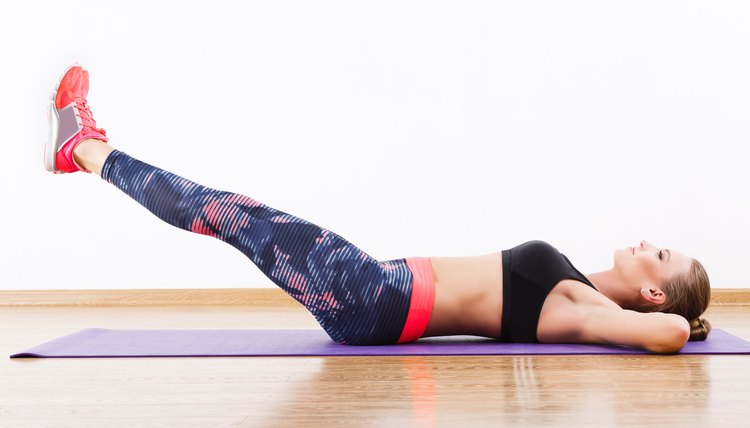TheraBand Exercises for Legs

TheraBands can be an extremely useful took for people looking to sculpt and strengthen their legs. Not only are they inexpensive and portable, but they can be used for a wide variety of exercises.
In addition, they come in a range of elasticity levels for both the novice exerciser and the veteran gym rat. Try these exercises to give your legs a well-rounded workout.
Individuals looking to strengthen their leg muscles using TheraBands should work these muscle groups two to three times each week. While doing so, perform two to four sets of eight to 12 repetitions of each exercise. As your workouts get less challenging, switch to a more resistive band to add to the difficulty. Be sure to discontinue any activity that causes increased pain.
1. Clam Shell
Clam shells strengthen several muscles that lend stability to the pelvis and aid in rotating your hip away from your body.
HOW TO DO IT: Lie on your side with your hips and knees bent and a band secured around them. Keep your feet together as you lift your top knee toward the ceiling. Do not allow your body to roll backward as you complete this motion. Once a set is finished, roll over and repeat the exercise with the other leg.
2. Fire Hydrant
Fire hydrants are an effective, yet challenging exercise for the glutes and the hip rotator muscles in your buttocks.
HOW TO DO IT: Get onto your hands and knees and fasten a TheraBand just above the knee joint. Keeping your right knee bent, lift your right leg away from your body and slightly in back of you. As you do this, make sure to squeeze your stomach muscles to prevent your pelvis from tilting. After a set on the right leg, complete the same motion with your left side.
3. Hamstring Curl
This exercise challenges the hamstrings, a group of muscles in the back of your thigh that helps you bend your knee and extend your hip.
HOW TO DO IT: Sit in a chair facing a door. Secure one end of the TheraBand in the door at knee level and loop the other end around your right ankle. Kick your right leg backwards toward your buttocks and hold this position for 1 to 2 seconds before releasing the band's tension and returning your leg to the initial position. When you complete a set, do the same exercise with the left leg.

TheraBand Exercises for Legs
4. Straight Leg Raise
Resisted leg raises work your quadriceps, a muscle group that activates when you run, jump or squat.
HOW TO DO IT: Lie on your back with a band looped around both of your ankles. Lift your right leg off the ground about eight to 12 inches without allowing the knee to bend. Keep the leg here for a second or two before lowering it back down again. Make sure you don't arch your back while lifting the leg. After a set, repeat the lifts with the left leg.
This exercise uses to a resistance band to incorporate your gluteus medius muscle into an already challenging quad workout.
HOW TO DO IT: Secure a TheraBand around your legs at calf level. Begin by bending your knees and assuming a slight squat. Your knees should stay aligned over your feet and should not pass beyond the end of your toes. Holding this position, step sideways to your right 10 times. Then, repeat the exercise to your left. Try not to let your body lean while you step.
6. Monster Walk
Monster walks challenge your hip flexor and hip abductor muscles on the front and side of your hips.
HOW TO DO IT: Place a band around both legs at knee level and spread your legs slightly wider than shoulder-width apart. Take a large step forward with one leg making sure to keep your legs spread wide as you do this, and then take a step with the other leg and continue to alternate. As the exercise becomes easier, you can make it more challenging by lowering the band to ankle level.
References
- Journal of Orthopaedic and Sports Physical Therapy: Gluteal Muscle Activation During Common Therapeutic Exercises
- Medicine and Science in Sports and Exercise: Quantity and Quality of Exercise for Developing and Maintaining Cardiorespiratory, Musculoskeletal, and Neuromotor Fitness in Apparently Healthy Adults: Guidance for Prescribing Exercise
Writer Bio
Tim Petrie is a Physical Therapist and an Orthopedic Certified Specialist working in Milwaukee, Wisc. When he isn't working, he loves distance running, Packers football, and traveling with his wife and his energetic kids.
